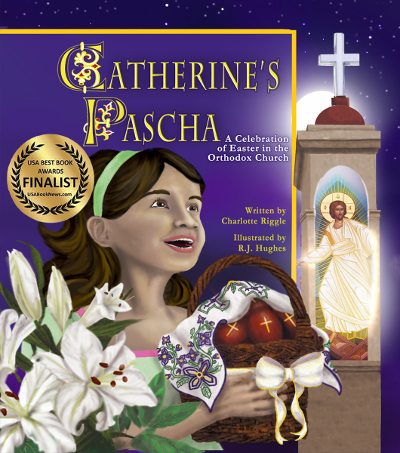In a way, Tekla’s Easter is a lot like Catherine’s Pascha. Both books tell the story of one little girl who is celebrating the feast of the Resurrection of Christ with her family and her church.
Of course, Catherine is an Orthodox Christian girl who lives in the United States, and she calls the feastday Pascha. Tekla lives on a little island off the western coast of Sweden, and she calls it Easter.
It would make a fabulous assignment, I think, for a teacher or parent to give both books to a student, and ask them compare and contrast the two celebrations.
Tekla’s Easter starts out on the day before Easter Eve – so on Good Friday. Tekla spends the day making Easter witches for an auction to raise money for the school lunchroom.
Until I’d read the book, I’d never heard of Easter witches. Now I know! Witches were once thought to fly to a mythical mountain to dance with the devil on Maundy Thursday, and to fly back home on Easter Eve. People put out the fires in their homes on Easter Eve and closed the dampers of their fireplaces to keep the witches out. Tekla’s grandmother does this, and Tekla observes that she still half believes.
Easter bonfires and firecrackers that were once meant to keep the witches away are still part of the celebration of Easter. Tekla is too young to dance all night around the bonfires. (She might be jealous if she knew that Catherine would be up all night at a party at church!) But she is not yet too old to dress up as a witch and ride a broom out into the night!
On Easter morning, everyone on Tekla’s island goes to church on the mainland. They dress in old-time costumes and go to church in a special boat. Tekla, for the first time, is allowed to ride in the prow of the boat. She considers this a real honor, and a sign that, if she’s not yet old enough for the bonfires, she is growing up.
When they get home, they have their Easter feast! The table is decorated with Easter flowers made from dyed feathers tied to birch twigs. The feast includes eating plenty of eggs, and telling Bible stories around the table.
The story, told by Lillian Budd, isn’t just a catalog of traditions. It’s a sweet story. The illustrations by Genia (an artist who uses only one name) are delightful. According to the back flap on the dust jacket, the costumes and settings are authentic, and the witches are drawn from actual Swedish straw witches that were loaned to her by the author.
Because it’s long, and the traditions will be unfamiliar to most children, I wouldn’t recommend it for preschoolers. Ages 6 to 10 seems about right.
Read More
Easter Picture Books Keep Pascha Present: You might be tempted to put the Easter picture books away during Bright Week. Don’t do it! By keeping them out, you’ll help your little one understand that Easter lasts more than a single day.
The complete list of multicultural Easter picture books: If you’re looking for picture books that show people celebrating the Resurrection of our Lord Jesus Christ, you’ll find them on this list. All of them. (Well, almost all.)
17 essential picture books for Orthodox Christian kids: If you’re looking for picture books that include stories about Orthodox Christian people and traditions, you’ll find them on this list.
Books by Charlotte Riggle

This holiday classic shares the joy of Pascha through the eyes of a child. Find it on Amazon or Bookshop.org.
![]()

This delightful story is filled with friendship, prayer, sibling squabbles, a godparent’s story of St. Nicholas, and snow. Lots and lots of snow. Find it on Amazon or Bookshop.org.
![]()

In this collection of essays, women who are, or have been, single mothers share stories of their relationships with saints who were also single mothers. Charlotte’s story of the widow of Zarephath highlights the virtue of philoxenia. Find it on Amazon or Park End Books.




